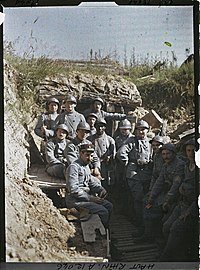Quibellan Civil War: Difference between revisions
old>Kisi No edit summary |
m (1 revision imported) |
Revision as of 07:08, 23 March 2019
| Quibellan Civil War | ||||||
|---|---|---|---|---|---|---|
| Part of Post-Republican War Conflicts | ||||||
 Quibellan Royalists pose for a picture in the trenches outside Cœur | ||||||
| ||||||
| Belligerents | ||||||
|
|
Socialist and Anarchist Forces | |||||
| Commanders and leaders | ||||||
|
|
|
Socialist and Anarchist Forces Including | ||||
| Strength | ||||||
| 725,000 (1899) | 500,000 (1899) |
250,000 (1899) 200,000 (1899) | ||||
The Quibellan Civil War was a multi-party war in Quibella immediately after the official coronation of King Phillipe III of Quibella, as many factions vied to determine Quibella's political future. The two largest combatant groups were the Quibellan Royalists, fighting to preserve the Monarchy in Quibella as well as, to protect various Quibellan minorities within Culsivan and Solivirian dominated provinces, and the loosely allied forces known as the Good Christian Army, which included diverse interests favoring republicanism, theologism and alternative forms of monarchism, each with democratic and antidemocratic variants. In addition, rival militant Luddites and Socialist and Anarchist Forces fought against both the Quibellans and the Soitirans. The Royal Army defeated the White Socialists and Anarchists in Ludęca and the army led by Clovis Barbet in Western Quibella in 1899. The remains of the Good Christian forces commanded by Henry Guilbert were beaten in Southern Quibella and evacuated in late 1901. Lesser battles of the war continued on the periphery for two more years, and minor skirmishes with the remnants of the Good Christian forces in the west continued well into 1902. The war ended in 1902 in the sense that the Royalist control of Quibella was now assured, although armed national resistance in Soliviria was not completely crushed until 1904. There were an estimated 1,000,000–5,000,000 casualties during the war, mostly civilians.